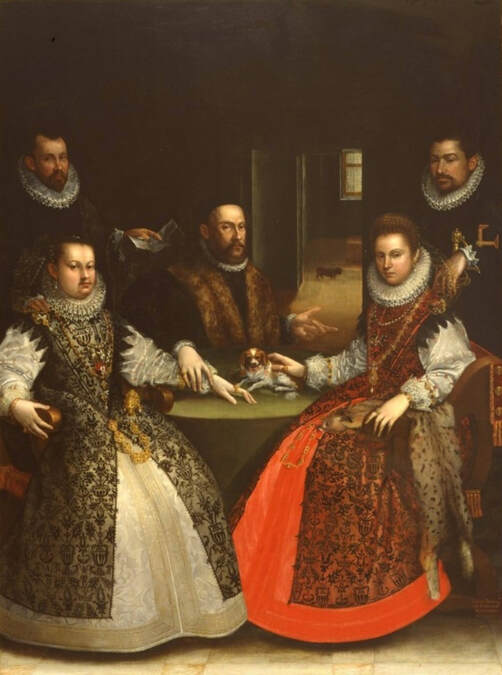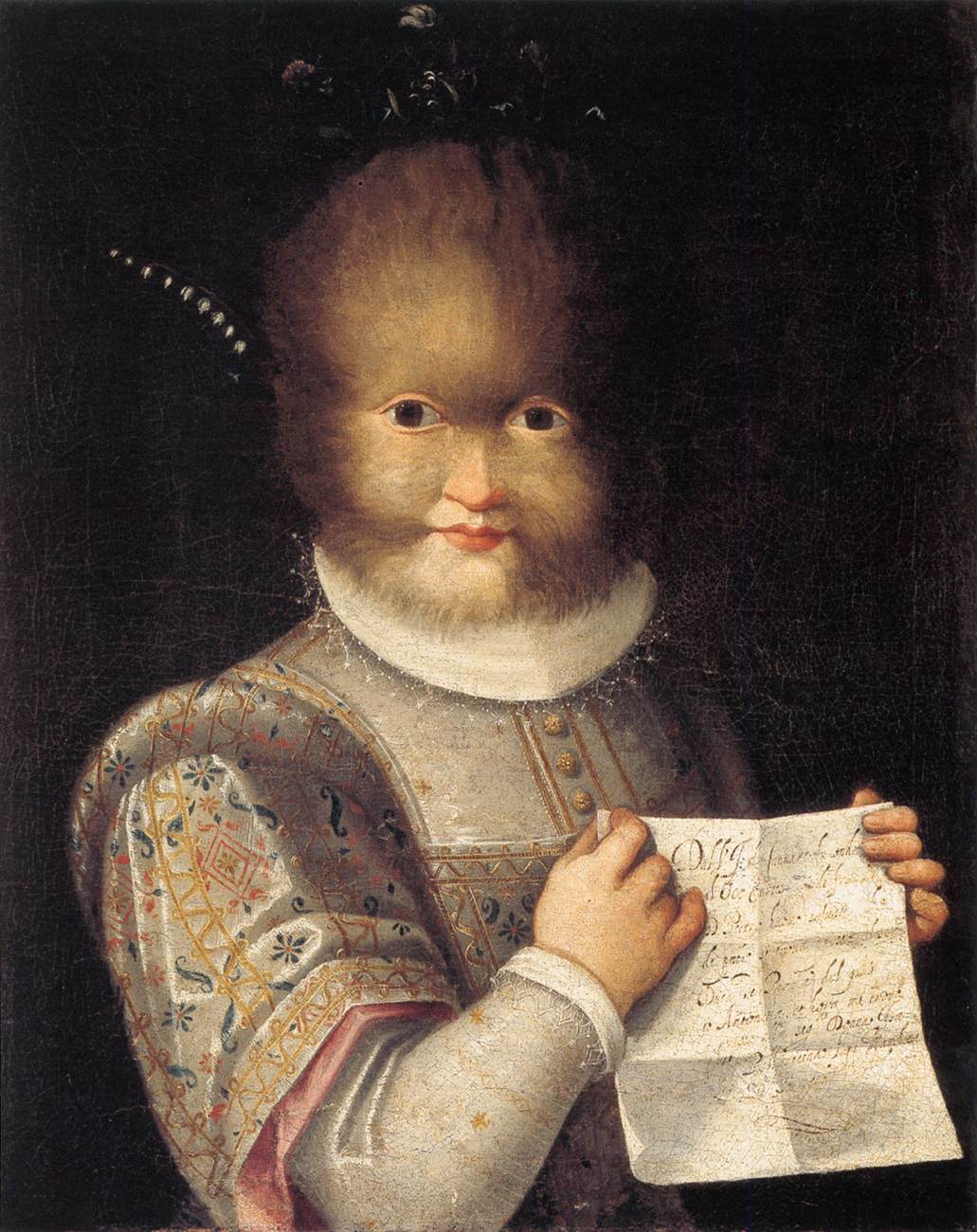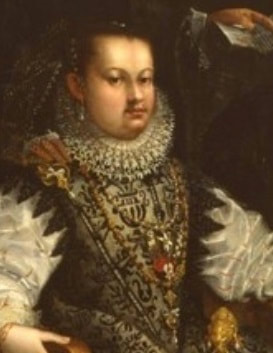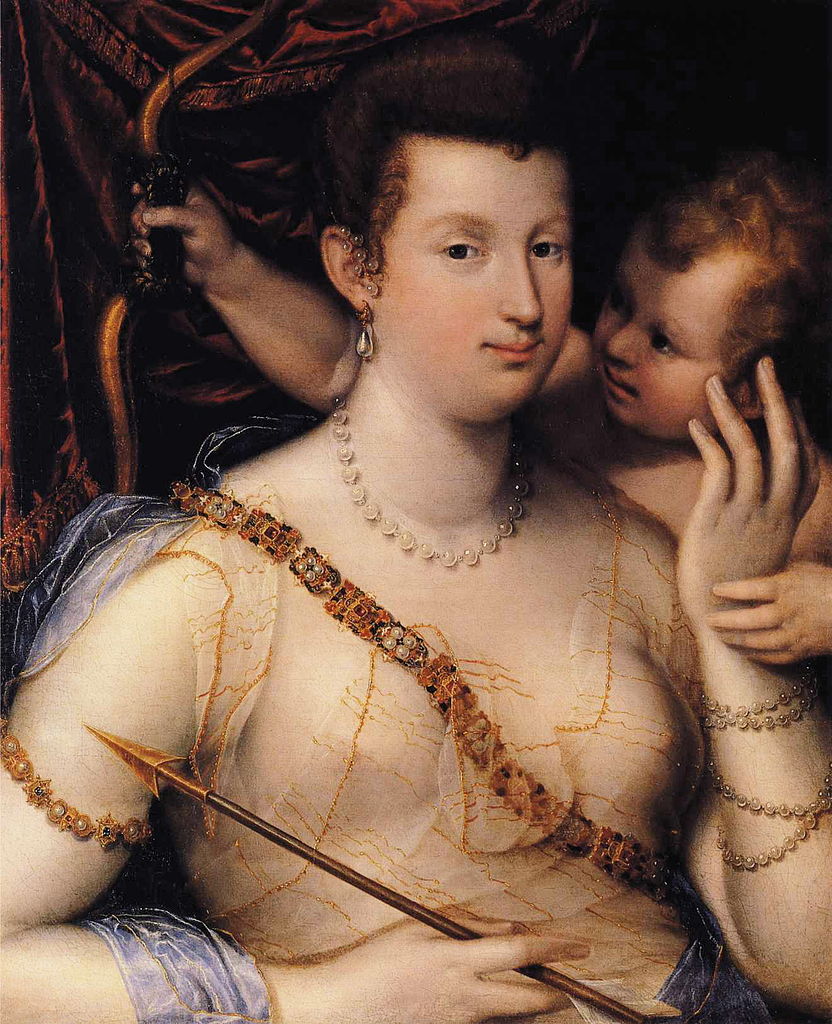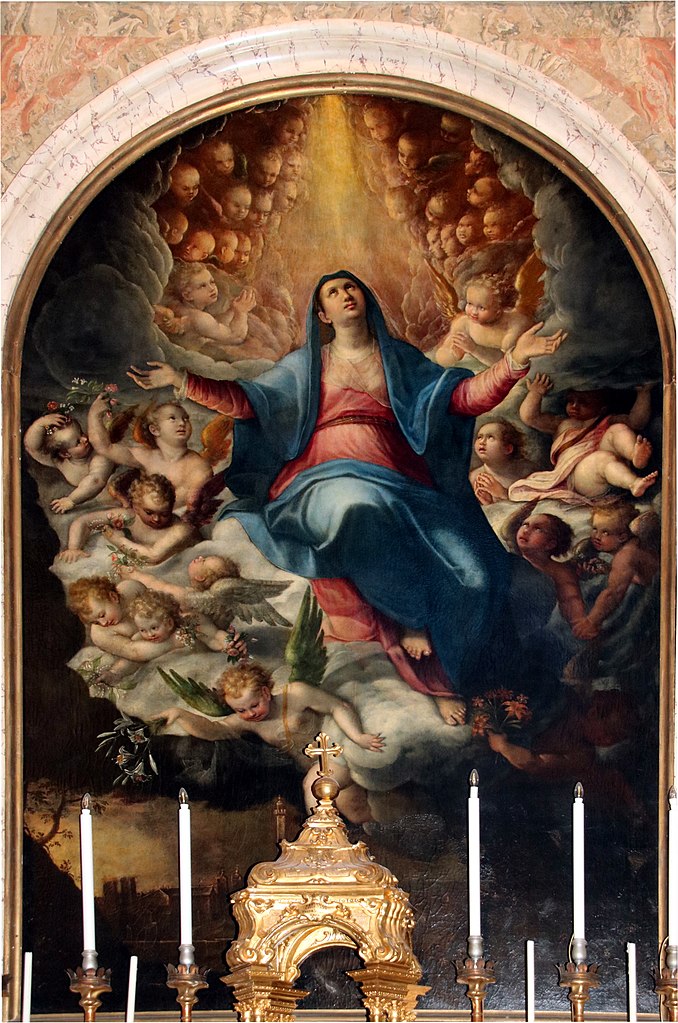|
Where? Pinacoteca Nazionale, Bologna
When? 1584 What? Oil on canvas, 250 x 189 cm (8.2 x 6.2 feet) Commissioned by: Laudomia Gozzadini Introduction: At first glance, one could easily pass by this portrait as yet another family using fancy clothes and jewelry to tell the world how important and influential they are, however, it would be a mistake to miss this. The painting exposes a dysfunctional family, 16th century style. Knowing who the people are and their backstories is the best way of interpreting the messages that the commissioner of the painting, Laudomia Gozzadini wished to include in her family portrait. She and Lavinia Fontana shared extremely intimate information in order for the artist to paint this artwork. It is a collaboration that is palpable in the painting.
Who are the people?
The Back Story: This is a story in a painting told by Laudomia Gozzadini. Lavinia Fontana, the artist, was well known for her work with noblemen and women in Bologna but this was her first documented commission from a Bolognese noblewoman. She presented the family as Laudomia wanted them to appear. Both women, Laudomia, 30 and Lavinia, 32, were matrons in the city in 1584. The Gozzadini were strong patrons of the arts and Lavinia Fontana would have been an easy choice for the commission as the two women came from compatible backgrounds. Despite their different social positions they obviously felt comfortable with each other. Lavinia was known for her empathetic approach to her patrons and Laudomia seems to have had no difficulty in sharing with the artist, the deepest, darkest secrets that she knew about her family. The two women became very good friends in the years following the painting. This is a close, intimate, collaboration between painter and commissioner. Ulisse died when Laudomia was about six and Ginevra was seven. His will elaborated details for the dowries, marriages and the various stipulations that were meant to keep the Gozzadini fortune within the family and guarantee the continuation of his family line. The dowries specified money for the expensive wedding attire that included clothing and jewelry along with properties that would belong to the two girls through the family. The advantages written into the will for the first couple to produce the male heir were the seeds of discontent planted long before the two sisters were even thinking about their marriages. Ginevra, as the elder daughter married the legitimate grandson of Gabbion Gozzadini, Annibale, so she, made the wealthier, more prestigious match. Laudomia, as the younger daughter, was married to the bastard but legitimized grandson of Gabbion Gozzadini. Camillo and Laudomia would have an up-hill battle and would have to pin their hopes on the future sons that Laudomia could produce in order to confirm their fortune within the family estate. The marriages took place in 1570, when Ginevra was seventeen and Laudomia was sixteen. Annibale was thirty-one, fourteen years older than Ginevra and Camillo was twenty-five, nine years older than Laudomia. On August 8, 1571, Ginevra gave birth to a son, named after his grandfather, Ulisse, and was soon declared heir to the estate. Children tended to die so it was important to continue to have children. Ginevra gave birth another six times and had two more sons survive infancy, Brandeligio and Claudio. Laudomia, on the other hand, had eight pregnancies but only two daughters survived. She did have three sons but all perished quickly. The last one, Gian Battista, died tragically, 25 days after birth when a maid servant rolled over in bed and suffocated him. Laudomia had not produced even one viable male heir, a disaster, that she blamed on her husband. He blamed her for the death of the third son because she had hired the maid servant. She had no more pregnancies and it is believed that she and Camillo had ceased intimate relations by this time. He proved to be a philanderer and had been unfaithful to her. His bastard children were cause for deep concern for Laudomia because if he legitimized them, her remaining two daughters could be pushed aside. Much later, she did write three wills in an attempt to prevent Camillo’s sons from inheriting any part of her estate. On top of the disappointment at the lack of an heir, cracks in the relationship between Ginevra, Annibale and Laudomia began showing up as early as 1579. Annibale began withholding money that Laudomia believed belonged to her through her family. She had a cheating husband and a dishonest brother-in-law and had lost the race for a male heir. However, Ginevra’s death in 1582 changed the dynamics of the situation. Two years later, perhaps in a state of some desperation, Laudomia took action and decided to commission a family painting as an expression of her loyalty to her blood relatives and as a means to tell her story. The Painting: This is not a typical family portrait for the time. Usually, such works would celebrate an important event, pay honor to dead relatives or confirm a family legacy. Laudomia has had Lavinia Fontana paint pointed, specific and personal messages in her telling of her tale of woe. (Emily Fedor) The tightly packed, life-size figures are striking. In the composition, the three people sitting at the table create a dominant triangle. Although the central position is normally the most powerful, the women become the main feature because of the frontal light source, their size and their positioning in the front of the painting. The two standing men fade into the background emphasizing the strongest relationship is between the father and the two daughters. They are the three blood relatives who are family. Ulisse wears his Senatorial dress: a black cloth gown, fur stole and a small black cap on his head. His clothing and central position indicate the importance and power he had in life. However, in death, he too, fades into the background where the back-light comes from a curtained window several rooms behind. Ulisse holds Genevra’s forearm cementing their relationship in death. The whiteness of their hands and the gown with the black overdress accentuates their deaths. Laudomia also wears a black overdress highlighting her loss of family and her state of mourning. Ulisse points to Laudomia in her bright red, satin dress with his left hand, which seems to be in an ethereal fog, retreating into the floor coloring. His gesture draws attention to her indicating that here, lies the future. She is the remaining adult family member. He and Ginevra are gone. All four other figures are turned towards Laudomia, driving further attention to her even though they are not looking at her specifically. She is the one, still full of life, vigor, color and attentiveness. Despite her problems with an errant husband, she seems ready to represent the family and be responsible for what belongs to them. The message in this triangle is family unity, family loyalty and belonging between these three people. There is another relationship of interest between Ginevra, Laudomia and the little lapdog. A tenuous connection between the two sisters is seen in the painting, as they only touch each other through the lapdog. In art, dogs have long been the symbol of status, loyalty, faithfulness and fidelity. This one seems to represent all meanings in this portrait with his bejeweled ears, neck and apparent pampered lifestyle.
Their marriages, Annibale’s controlling manner and Ginevra’s death have separated the sisters. In the painting, the little dog facilitates the re-establishment of their relationship by providing a link between the two sisters hands. Laudomia actively pats the dog while the dead hand of Ginevra remains passive. In other words, despite the problems with Annibale, Laudomia's inability to produce a male heir and Ginevra’s passing, Laudomia is still family and the sisters must be loyal to each other, whether dead or alive. The shared property and wealth from their father and other family members, should remain with Laudomia, following the deaths. She is the remaining immediate blood relative.
Ginevra has been portrayed as a rather plump, unattractive woman and Laudomia could easily be accused of taking a bit of revenge for Ginevra’s lack of loyalty to her. She was probably jealous of the reproductive success in her sister’s marriage. After all, Ginevra did produce the only male heirs and that could not have made her sister happy, given the circumstances of the will, left by Ulisse. Annibale stands behind Genevra with his right hand firmly planted on her shoulder. This may indicate the solidarity that was between Ginevra and Annibale but it could also be a message referring to Annibale’s firm control over Ginervra, at least in Laudomia’s mind. He holds a piece of white paper in his left hand and extends it towards Ulisse. He had gradually taken over responsibility for the family estate, including Laudomia’s dowry in 1576 and the land that the sisters had bought with monies from various family inheritances in 1581, when Ginevra died. According to Emily Fedor; “after the deaths of Ginevra and several aging trustees, Annibale took over complete management of the estate and began withholding money from Laudomia as early as 1579. She felt the wealth of her own family start to slip inexorably from her grasp”. Camillo stands with his fingertips barely touching Laudomia indicating the break-down of their relationship and their disconnection from each other. It seems a slight gesture but is a powerful message of failure for both of them. The biggest failure was the inability to produce a male heir. And fertility is a major issue. Ginevra has a fur pellet attached to her girdle which was considered an aid to fertility but Laudomia wears a very large lynx pelt that covers her lap and hangs down to the bottom of her dress hem. The lynx is associated with chastity and sharp sight. The lynx eye looks directly at the viewer keeping his “sharp eye out”. Emily Fedor proposes that Laudomia is telling the world she was aware of the ways in which Annibale and Camillo were mistreating her and that she was unwilling to be deceived. These accessories also underscore the childbearing successes or failures of each woman. Laudomia wanted no mistake made as to the virility of their respective husbands. Careful observation of the tiny miniatures at the end of their respective gold chains, reveal paintings of nude men, each displaying their sexual prowess or lack thereof. Lavinia must have taken instruction from Laudomia for this piece of jewelry to be painted into the portrait. The replication of the family jewels in the painting provides another message of “patrilineal wealth”. It is the women who display the riches. The two husbands in the background, indicate nothing of their personal wealth. Annibale holds the paper which probably refers to his responsibility for the estate and Camillo simply rests on the sword that reveals his membership in the Portuguese order of Christ. (Knights Templar order as it was reconstituted in Portugal after the Templars were abolished on March 22, 1312 by a papal bull.) The women are associated with their father and distanced from their husbands by the very wealth they display. Both wear strands of pearls, gold chains, rings and bracelets with gems. Their embossed wedding gowns are not a display of wedding celebration. (Receipts were found for a white and red gown in financial records as well as much of the jewelry worn in 1570 for the two weddings.) They are a statement of the property that their father financed for their weddings. The gowns and jewels are elaborate and expensive and another definitive connection to their father. Women normally would identify with their husband’s family after marriage. Laudomia is trying to make certain that the family ties are the ties that bind and she is proclaiming loud and clear that she relates to her blood relatives, she is the one that remains and that what was theirs should now belong to her. There is a black dog wandering through the back room with several proposals for its reason to be there. One suggests he simply indicates the size of the mansion and that it is part of the wealth of the estate. Another interpretation highlights that he is free to wander and go where he pleases, whereas the little dog on the table is trapped, much in the manner that Laudomia was trapped in her situation. Perhaps the most sensible message that the black dog may be conveying in the circumstances, is that he represents the treachery that the painting is portraying. He is in the background, ever present. In the Middle Ages, black dogs often represented evil, and there was carry over of this symbolism into the Renaissance. This painting remained in her family for the rest of her life and she put great value on it and on her friendship with Lavinia. Laudomia was godmother to one of Lavinia’s sons and one of her daughters who was named “Laudomia”. Like her father and his desire to maintain his estate, she too wanted to preserve this painting and see it handed down for posterity within the male heirs of her family. Who is the artist? Lavinia Fontana was born in Bologna in 1552 and died in 1614 aged 62. She was the daughter of Prospero Fontana, a well-known artist and teacher. Lavinia may from been drawing and painting early in her life but evidence suggests that her father did not begin training her until she was in her teens. He lost one of his wealthy patrons and saw his income declining. Lavinia showed great promise and Prospero educated her with the hopes that she would take over his studio. Early in her career she followed her father in his Mannerist style where proportion, balance and beauty were emphasized to the point of exaggeration. (elongated figures, stylized poses, and distorted perspective). It was first recognized about 1520 and remained a force until the end of the 16th century. Lavinia later trained with Ludovico Carracci. She modified her work towards Baroque Classicism (realism, broad strokes, colors evoking mood). She attended the University of Bologna and was listed as “Donne addtrinatte” or women with doctorate in 1580. She was well educated and unlike any other female artists who were becoming successful in the same era, she was the first to make a career in art in Western Europe. Her commissions were her income and she supported her entire family. She married Gian Paolo Zappi in 1577 when she was 25. He was one of Prospero’s students. He was willing to subordinate his career to hers and he became not only her manager but also her “house husband”. He ran the household which included themselves their children, Prospero and his wife. Livinia had eleven pregnancies and reportedly went straight back to painting immediately following the birth of each child. Only 4 of the children survived and only 3 lived past Lavinia’s death in 1614. Gian also continued to paint the backings or drapery of her paintings. In the marriage agreement, Prospera, had insisted that Gian move to Bologna into the Fontana family home and that they would stay there until Prospero died. He also made certain that Lavinia’s earnings went into his coffers with the understanding that he would support them all from their combined monies until he died. No dowry was paid and it all seemed to work well. Initially, Lavinia’s commissions came from religious devotionals. These were small works painted on copper and very popular as papal and diplomatic gifts. It took time for her to develop a following for her portraiture. And as mentioned above, it was Laudomia who gave her, her first commission for a portrait in the world of noblewomen and men. Laudomia Gozzadini’s commission and the resulting portrait provided great impetus to her career and opened many doors. She had been painting important people in Bolognese society for some time but the noble families paid her excellent fees and she was able to make a very good living for her family. They appreciated her attention to detail, her precision, her delicacy and her understanding of humanity. She became friendly with many of her female clients and any contemporary description of her is complementary. Several portraits of Ulisse existed for Fontana to use as reference to paint his likeness. Laudomia’s memories of him would have been vague as she was only 6 when he died. There are several sketches of young men that Lavinia drew that could be related to Annibale and/or Camillo. One of her earliest paintings, now lost, was titled, “Monkey Girl” (1575). She was 23 at the time and did another similar work in 1595, Portrait of Antoinetta Gonzalez, (below) who suffered the rare genetic disorder, hypertrichosis (the body produces excessive hair). Perhaps her first rendition was a prototype for Ginevra as there are too many similarities to ignore. Facial shapes, hairlines, and a slight darkening of the chin area suggests facial hair. It is also very coincidental that she would produce this painting of Antoinetta, a year after painting the Gozzadini portrait. There are no known portraits of Ginevra and again, Laudomia must have had some input into how her sister should appear, even as she professed loyalty, the portrait is anything but complimentary to her sister.
The Portrait of the Gozzadini Family was a turning point for both these women. A story was finally told and a career was in the making.
Lavinia Fontana and her husband complied with the wishes of her father and remained in Bologna until he died. Her reputation continued to grow and she expanded her repertoire to include the genres of mythological and religious painting. Venus and Cupid (below) is an example of her use of a mythological tale to disguise a portrait that could have been an engagement gift to be sent to the groom. She was also the first woman to portray nude women which was remarkable as female painters were forbidden to view any nudity. Their experience with the human body consisted of plaster cast models. The myths provided an excuse for both men and women to paint nude bodies.
Religious subjects remained one of Lavinia’s strong points throughout her career. This complicated, truly Renaissance, hierarchical work can be seen today at the alter of the Blessed Sacrament in the Pieve di Cento, Collegiata di Santa Maria Maggiore.
She moved with her family to Rome in 1603 by invitation of Pope Clement VIII and was eventually appointed official painter to the papal courts. She was equally successful in Rome as she had been in Bologna and received many awards for her work. One such achievement was her election into the Accademia di San Luca of Rome. This was a group of artists founded in 1577 under the directorship of Frederico Zuccari, (a Mannerist painter and architect). The purpose of the group was to elevate the work of painters, sculptors and architects. End Result: Caroline P. Murphy elaborated the end result of this long-standing injustice. Ten years after the painting, in 1594, Camillo was elected the Bolognese ambassador to Rome. He, Laudomia and one of their daughters, Berenice moved to Rome and lived on Piazza Navona (their other daughter had entered a convent). A flood on Christmas Eve, 1598 caused great damage to their home and possessions. Camillo wrote to Annibale requesting financial help to replace the lost items. Annibale had continued to ignore Laudomia’s rights to the monies earned from the agricultural property that she and Ginevra had owned together. In Rome, the payments had almost ceased and he again ignored the letter from Camillo. Laudomia wrote to Annibale herself and through conversations with others he claimed he had paid her and that she was a liar. She then attempted correspondence with her nephew, Brandeligio with no better results. She threatened a law suit but without Camillo’s approval, she could not pursue it. Camillo refused to allow her to do so because he was dependent on Annibale for occasional loans, gifts of money or wished to trade on his influence. A lawsuit finally began a year after Annibale died. Camillo had nothing to lose and perhaps something to gain if his wife won so he finally gave his approval. The suit was between Laudomia and her nephews, Ulisse, Brandeligio and Claudio. It was a tortuous process of questions and statements to be answered and Laudomia was not allowed in court and could only answer in cursory responses. In 1614, there is a letter written by Camillo, claiming victory for Laudomia over her relatives. Perhaps the saga ended here but clearly, Laudomia believed her case to be honorable and worth the over 35 years it took to pursue justice in her life. Written by Carol Morse
References
0 Comments
Leave a Reply. |
Categories
All
|
- Home
- Blog
-
Museums
- Alte Pinakothek
- Art Institute of Chicago
- Baltimore Museum of Art
- Barber Institute of Fine Arts
- Bargello
- Barnes Foundation
- British Museum
- Church of Sant’Anastasia
- Cleveland Museum of Art
- Courtauld Institute of Art
- Detroit Institute of Arts
- Frans Hals Museum
- Galleria Borghese
- Gallerie dell'Accademia
- Getty Museum
- Guggenheim
- Hermitage Museum
- Kunsthistorisches Museum
- Kunstmuseum Basel
- Legion of Honor Museum
- Louvre
- Mauritshuis
- Metropolitan Museum of Art
- Musee d’Orsay
- Museum of Fine Arts in Boston
- Museum of Modern Art
- National Gallery in London
- National Gallery of Art
- National Museum in Poznań
- Norton Simon Museum
- Ny Carlsberg Glyptotek
- Palace of Versailles
- Palazzo Pitti
- Palazzo Vecchio
- Petit Palais
- Philadelphia Museum of Art
- Prado
- Pushkin Museum
- Ravenna Art Museum
- Rijksmuseum
- San Diego Museum of Art
- Santa Maria delle Grazie
- St. Peter's Basilica
- Städel Museum
- Statens Museum for Kunst
- Tate Britain
- Tate Modern
- Timken Museum of Art
- Uffizi
- Vatican Museums
- Wallace Collection
-
Artists
- Altdorfer
- Anguissola
- Berlin Painter
- Bosch
- Botticelli
- Boucher
- Bronzino
- Bruegel the Elder
- Brunelleschi
- Cabanel
- Caillebotte
- Canova
- Caravaggio
- Carpeaux
- Cezanne
- Cimabue
- David
- Degas
- Delacroix
- De Maria
- Donatello
- El Greco
- Fontana
- Fra Angelico
- Fragonard
- Gauguin
- Gentileschi
- Gericault
- Gonzalez-Torres
- Goya
- Hals
- Hogarth
- Hokusai
- Ingres
- Leonardo da Vinci
- Lippi, Filippo
- Longhi, Barbara
- Lorrain
- Makovsky
- Manet
- Massys
- Matisse
- Merian
- Michelangelo
- Mochi
- Modigliani
- Monet
- Panini
- Parmigianino
- Perugino
- Picasso
- Pisanello
- Raphael
- Rembrandt
- Renoir
- Reynolds
- Rivera
- Rodin
- Rubens
- Scultori
- Seurat
- Steen
- Tintoretto
- Titian
- Toulouse-Lautrec
- Turner
- Uccello
- Van der Weyden
- Van Dyck
- Van Eyck
- Van Gogh
- Van Hemessen
- Vasari
- Velazquez
- Vermeer
- Veronese
- Vigée Le Brun
-
Locations
- Books
- About Us

